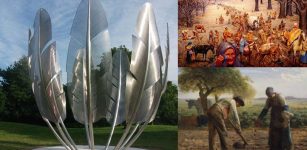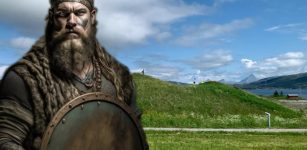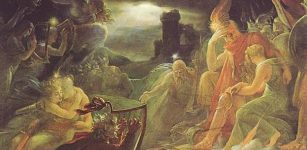Vikings’ Legacy Is Still Alive In Ireland – DNA, Ancient Ruins And Modern Cites Reveal
Jan Bartek - AncientPages.com - Vikings left an everlasting legacy in Ireland. While you are in Ireland, you can visit archaeological places where battles between Vikings and the Irish were fought. Many ancient ruins in Ireland tell a lot about the country's Viking heritage.
Skeletons of Norse warriors and their artifacts are still unearthed in Ireland. DNA studies have revealed the Irish are much more genetically diverse than previously believed and have Viking and Norman ancestry. A comprehensive DNA studied showed 20 % of the Irish population can trace their origin to the Norsemen!
Add to this the fact the Norsemen founded many of the island Nation’s towns and cities, including its capital, Dublin, and the picture becomes clear. The Vikings’ legacy is still alive in Ireland.
Ireland’s Population Was in Decline Before The Arrival Of The Vikings
The first historical record of Vikings in Ireland occurred in 795 when the Norse warriors invaded the country. During the Viking raid, Rathlin Monastery was destroyed. This was the beginning of the Viking Age in Ireland, which lasted a little more than 200 years. From a historical perspective, it is a brief period, but those years were enough to leave a Viking legacy that still lasts.
Vikings did plunder a lot in Ireland. Monasteries were the main target because it was believed valuable treasures were stored there. However, the Norsemen also contributed to the creation and expansion of settlement, trade, and urbanization.
According to scientists from the Queen’s University Belfast, the population of Ireland was in serious decline for almost 200 years before the Vikings settled.
When the Vikings reached Ireland much changed. Credit: Adobe Stock - Vlastimil Šesták
“Around the year 700, this population in Ireland mysteriously entered a decline, perhaps because of war, famine, plague or political unrest. However, there was no single cause or one-off event, as the decline was a gradual process.”
The Vikings settled in Ireland in the tenth century, during the phase of decline and despite being few in number, they were more successful than the ‘natives’ in expanding their population. Today, genetic evidence suggests many Irish people have some Viking blood.” 1
Vikings Founded Many Cities And Towns In Ireland – Including Dublin
In the 9th century, the Vikings invaded the region around Dublin and established the Norse Kingdom of Dublin. “To the Vikings, the area around Dublin was in many ways an ideal place. It offered access to the deep waters and shelter from the often stormy Northern seas. The Irish climate was relatively mild, and there was access to vast forests- a valuable resource to repair their sturdy ships. The Kingdom of Dublin was established in 839, and Viking Chief Turgesius was its first king.
The new town of Dublin was fortified with a ditch and an earth rampart with a wooden palisade on top. Dublin became the earliest, largest, and most enduring Norse kingdom in all of Europe. The huge number of Viking artifacts and burials discovered in Dublin attest to this.
1014: Dublin 1,000 years ago, based on research by Dr. Patrick Wallace
In the late 11th stone walls were built around Dublin. The Vikings also erected an artificial hill where the men of Dublin met to make laws and discuss policy.” 2
Vikings also established other bases, including Waterford, Limerick, Cork, and Wexford. During excavations in Cork, archaeologists discovered a Viking settlement that is almost 1,000-year-old. All these Viking settlements became eventually “Ireland's first towns during the 10th century – a revolutionary development that helped transform Irish society.” 3
Viking DNA In Ireland
Norse Vikings' impact on the modern Irish genome has previously been largely unknown, but now there is more meaningful information on this subject. Some years ago, a massive Irish DNA Atlas project released the results of a comprehensive study. Researchers announced that 20% of the Irish populations are descendants of the Norsemen. In addition, scientists also discovered a strong Irish presence in Norway, about 6%.

The clustering of individuals with Irish and British ancestry based solely on genetics. Shown are 30 clusters identified by fine structure from 2,103 Irish and British individuals. Credits: RCSI (Royal College of Surgeons in Ireland) and the Genealogical Society of Ireland
According to scientists, there was a “surprising amount of Norwegian-like ancestry in our Irish clusters. We also detected high levels of Norwegian ancestry in Orcadian and Scottish clusters and relatively low Norwegian ancestry in English and Welsh clusters. The Norwegian clusters that contribute significant ancestry to any Irish or British clusters predominantly consist of individuals from counties on the north or western coasts of Norway These areas are noted to be regions where Norse Viking activity originated from.” 4
Vikings were present in Ireland until the famous Irish hero Brian Boru forced the Norse warriors to leave his country. The battle took place on 23 April 1014 at Clontarf, near Dublin and it was a deceive moment in the history of Ireland. Just like many other freedom fighters, Brian Boru paid the highest price for the nation’s liberty. The Norse warriors killed him in a surprising attack.
Vikings left Ireland, but as you have just seen, their legacy is still alive, and it will be for a long, long time.
Written by Jan Bartek - AncientPages.com Staff Writer
Copyright © AncientPages.com All rights reserved. This material may not be published, broadcast, rewritten or redistributed in whole or part without the express written permission of AncientPages.com
Expand for references- Conny Waters - Ireland’s Population Was In Decline When Vikings Arrived To Settle, AncientPages.com
- Ellen Lloyd - Norse Kingdom Of Dublin Was Founded By The Vikings In 839 A.D., AncientPages.com
- National Museum Of Ireland - The Viking Age In Ireland
- Gilbert, E., O’Reilly, S., Merrigan, M. et al.The Irish DNA Atlas: Revealing Fine-Scale Population Structure and History within Ireland. Sci Rep 7, 17199 (2017). https://doi.org/10.1038/s41598-017-17124-4
More From Ancient Pages
-
 Kindred Spirits: Why Did The Irish Build A Monument In Honor Of Native Americans?
Ancient History Facts | Oct 22, 2016
Kindred Spirits: Why Did The Irish Build A Monument In Honor Of Native Americans?
Ancient History Facts | Oct 22, 2016 -
 Mystery Of The Knights Templar – Secret Mission And Loss Of A Great Treasure – Part 2
Ancient Mysteries | Aug 23, 2019
Mystery Of The Knights Templar – Secret Mission And Loss Of A Great Treasure – Part 2
Ancient Mysteries | Aug 23, 2019 -
 How Strong Is The Link Between Sanskrit And European Languages?
Linguistic Discoveries | Aug 5, 2020
How Strong Is The Link Between Sanskrit And European Languages?
Linguistic Discoveries | Aug 5, 2020 -
 Secret Ancient Knowledge Of Portals Leading To Unknown Realms – Mysteries Of The Past And Present – Part 2
Ancient Mysteries | Dec 7, 2021
Secret Ancient Knowledge Of Portals Leading To Unknown Realms – Mysteries Of The Past And Present – Part 2
Ancient Mysteries | Dec 7, 2021 -
 82 Mysterious 3,000-Year-Old Pits Discovered In Sweden – Bronze Age Cooking Pits And Ancient Ceremonial Center?
Archaeology | Jun 13, 2017
82 Mysterious 3,000-Year-Old Pits Discovered In Sweden – Bronze Age Cooking Pits And Ancient Ceremonial Center?
Archaeology | Jun 13, 2017 -
 On This Day In History: Supernova Observed In The Constellation Cassiopeia Was Recorded – On August 4, 1181
News | Aug 4, 2016
On This Day In History: Supernova Observed In The Constellation Cassiopeia Was Recorded – On August 4, 1181
News | Aug 4, 2016 -
 Hidden Text Discovered Inside Ancient Scroll
Archaeology | Oct 5, 2018
Hidden Text Discovered Inside Ancient Scroll
Archaeology | Oct 5, 2018 -
 Is Mysterious Herlaugshaugen The Ship Burial Of Viking King Herlaug?
Archaeology | Jul 11, 2023
Is Mysterious Herlaugshaugen The Ship Burial Of Viking King Herlaug?
Archaeology | Jul 11, 2023 -
 Exceptional 1,700-Year-Old Roman Mosaics Have Returned Home To Israel
Archaeology | Jun 27, 2022
Exceptional 1,700-Year-Old Roman Mosaics Have Returned Home To Israel
Archaeology | Jun 27, 2022 -
 Callacpuma’s Megalithic Stone Circular Plaza Was Constructed Using A Technique Previously Unseen In The Andes
Archaeology | Feb 15, 2024
Callacpuma’s Megalithic Stone Circular Plaza Was Constructed Using A Technique Previously Unseen In The Andes
Archaeology | Feb 15, 2024 -
 Is Legendary Norumbega In North America A Lost Viking Settlement?
Featured Stories | Jan 8, 2021
Is Legendary Norumbega In North America A Lost Viking Settlement?
Featured Stories | Jan 8, 2021 -
 Secrets Of Viking Crystal Sunstones Revealed By Modern Science
Archaeology | Apr 5, 2018
Secrets Of Viking Crystal Sunstones Revealed By Modern Science
Archaeology | Apr 5, 2018 -
 Lady Fu Hao: Brave Warrior Skilled Strategist And China’s First Female General
Featured Stories | Mar 9, 2019
Lady Fu Hao: Brave Warrior Skilled Strategist And China’s First Female General
Featured Stories | Mar 9, 2019 -
 Norse Kingdom Of Dublin Was Founded By The Vikings In 839 A.D.
Ancient History Facts | Mar 15, 2016
Norse Kingdom Of Dublin Was Founded By The Vikings In 839 A.D.
Ancient History Facts | Mar 15, 2016 -
 1154 Ancient Holes At Løykja Reveal Something Extraordinary – Archaeologists Say
Archaeology | Jul 17, 2020
1154 Ancient Holes At Løykja Reveal Something Extraordinary – Archaeologists Say
Archaeology | Jul 17, 2020 -
 Mysterious Mustatils- Giant 7,000-Year-Old Stone Monuments In Saudi Arabia Baffle Scientists
Archaeology | Aug 19, 2020
Mysterious Mustatils- Giant 7,000-Year-Old Stone Monuments In Saudi Arabia Baffle Scientists
Archaeology | Aug 19, 2020 -
 Discovery Of Queen Nefertiti’s Mummy Will Be Announced Next Month – Zahi Hawass Says
Archaeology | Sep 16, 2022
Discovery Of Queen Nefertiti’s Mummy Will Be Announced Next Month – Zahi Hawass Says
Archaeology | Sep 16, 2022 -
 Shining Ones And Magic In Ireland – Secret Wisdom Of The Gods
Celtic Mythology | May 9, 2014
Shining Ones And Magic In Ireland – Secret Wisdom Of The Gods
Celtic Mythology | May 9, 2014 -
 On This Day In History: Foundation Stone Of The Royal Greenwich Observatory In London Was Laid – On August 10, 1675
News | Aug 10, 2016
On This Day In History: Foundation Stone Of The Royal Greenwich Observatory In London Was Laid – On August 10, 1675
News | Aug 10, 2016 -
 Secrets Of Egyptian Painters Revealed By Chemistry
Archaeology | Jul 13, 2023
Secrets Of Egyptian Painters Revealed By Chemistry
Archaeology | Jul 13, 2023



